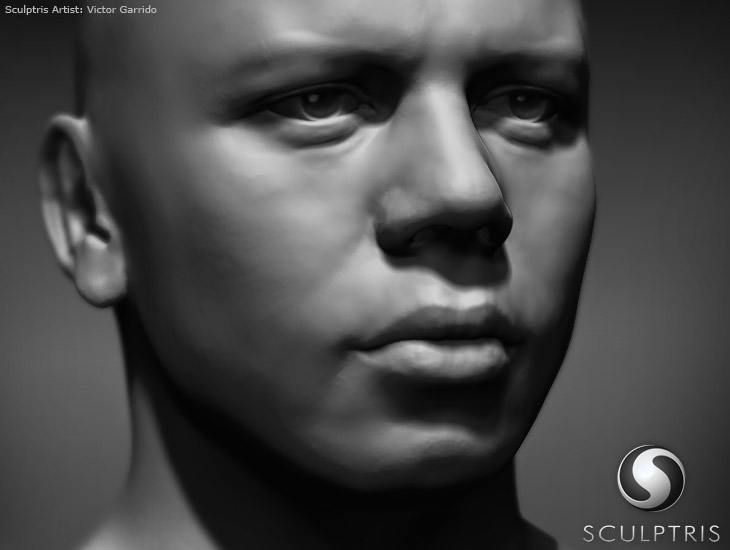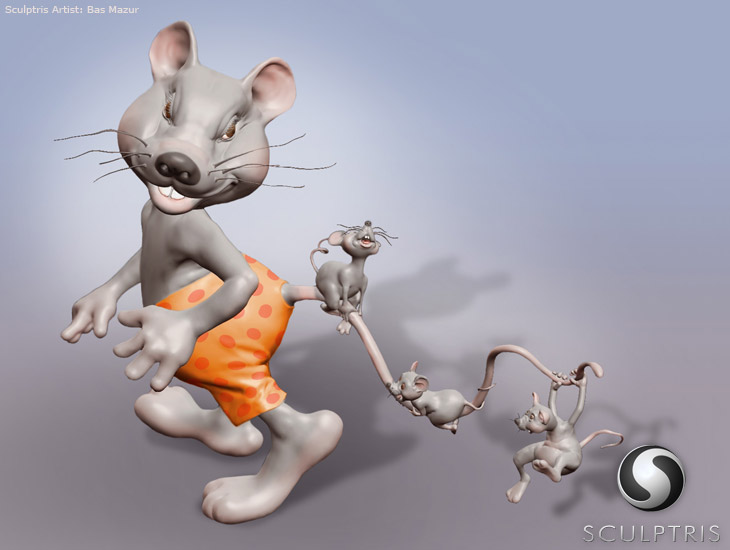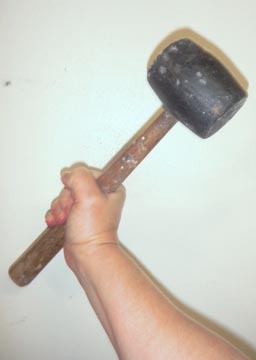3D
The Process – The Reason For A Digital Model

In traditional sculpting process a sculptor might present pencil sketches to a client to approve a design. Instead we sent digital models. The reason for these models are that we can see what a sculpture will look like from all directions. Sculpting is not like painting, you have to walk around the sculpture and have it present well from all sides. Digital models help us to do that. Another aspect of the digital model is that I can sculpt on it in the computer adding some detail before sending it off for enlargement. The digital model will really aid us in enlarging this sculpture as you will soon see. Before sending this off for enlargement the university requested I change the shape of the tail. They are concerned with breakage. We tried different tails with the pose and settled on something similar to this. Of course these are only digital sketches, of the direction we are going.
This is from the Prairie View A&M Blog created for this project.
One Last Look at The Prairie View A&M Poses
My client, Prairie View A & M had some revisions and wanted an adjustment to poses. These were sent to them today. We are behind about 3 weeks on our deadline. Once we have these approvals I’ll be working closely with my vendors. Synappsys Digital Services is going to enlarge and mill this out for me in foam creating a large foam armature. I am trying to secure an apprentice to assist me for the next three weeks of very long days. I actually only have two weeks to sculpt this to get back on schedule. I am not sure that is physically possible, but if I score and secure the intern/apprentice I hope to get, I think I will be fine. Tired but fine!
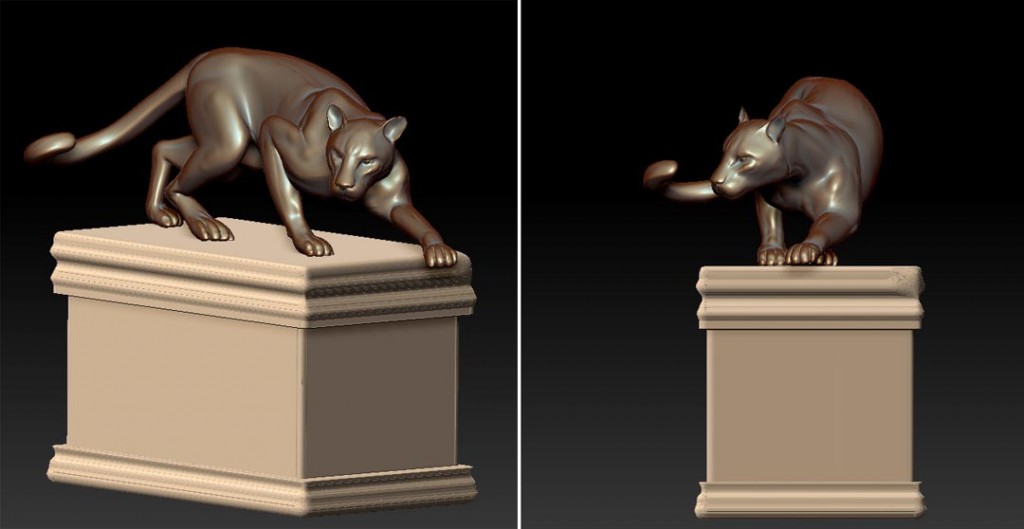
These are digital sketches. Created using a 3d model found in Content Paradise and using Carrara to pose it, Mudbox and Zbrush to work on the some of the detail. It is impossible to get exactly what we want to see in a large sculpture.
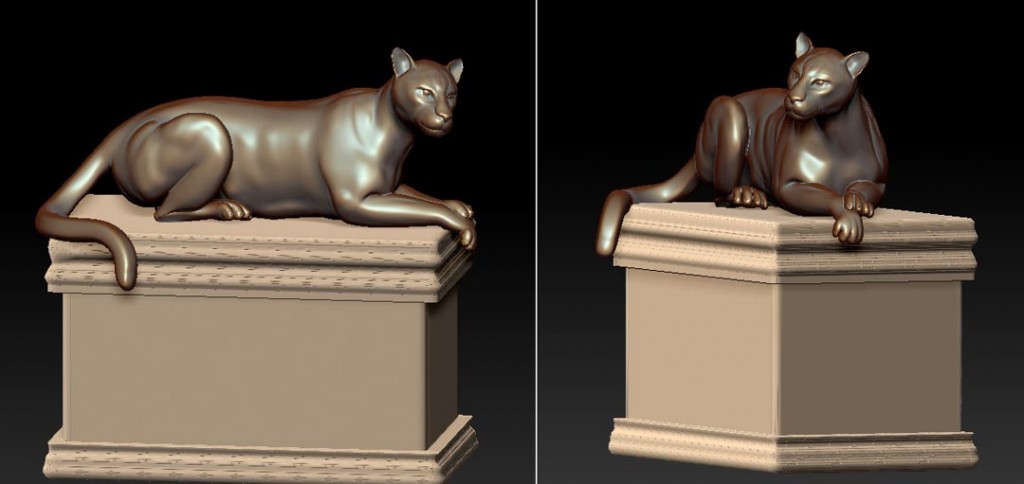
There are several reasons. Just as it would be difficult creating a small maquette in clay that would be enlarged to a big cat. A sculptor sculpts to the eye and how it is viewed. The eye sees things differently large than it does small, and some things just won’t translate. That is why my client will be asked to approve the final sculpted piece before it goes to bronze.
To see these images larger, just click on each. I can’t wait to get the armature back and work on this.
Searching For a Final Pose
I should know which sculpture Prairie View A&M will pick. For those looking for still images instead of the images in the video showing all sides of the sculpture, here are stills of the 5 poses.
As I told my client- Please remember these are just sketches. Most artists do pencil sketches. I like these 3d models as we can get a feel for what a pose looks like from all sides. Once we pick a pose I can then do the detail on the sculpture, add muscle and more panther structure, and will send that to my client. When I do, I will be sure to send them close up of the face and expression as well as the figure. Even more detail will come with the large sculpture created in clay.


So Excited- FREE 3D Sculpting With Pixologic? Try Sculptris
The new version of Sculptris is currently available as a free download at: www.pixologic.com/sculptris I can hardly wait to download it and give it a try. Thanks Pixologic for offering this free and for making it in both platforms (Mac and PC). We Mac users appreciate your diligence.
So, 3d sculptors weigh in. I can’t wait to see what you create and hear what you have to say. Download it, try it out, and send me an email with your thoughts and comparisons.
Here is what Pixologic says in their press release.
Sculptris is an elegant and simple 3D modeling solution, offering artists a platform to harness their imagination and create 3D sculpts in a way that is unique to the digital world.
Tomas Pettersson, the bright young programmer and brainchild behind Sculptris commented: “I trust that, with this version, Sculptris will be more accessible for all people on both PC’s and Mac’s. Everyone should be able to sculpt!”
Sculptris introduces a dynamic tessellation system, giving its user the capability to sculpt or paint freely on any part of the surface without having to worry about underlining geometry. With Sculptris, triangles are automatically added as needed, and only to the areas where a stroke has been applied to the surface.
Users can do just about anything that’s possible with real clay. For example, they can pull, twist and pinch the surface, easily adding volume as needed without the rigorous attention to underlying structure that is typically associated with 3D modeling programs.
Pixologic envisions Sculptris as an entry level ‘eye opener’ for a new generation of artists wishing to explore 3D sculpting and digital creation. Fun to use, it’s also a truly effective tool that can be embraced by hobbyists and professional artists, alike.
For those wishing to explore further, Sculptris is seen as a perfect ground level upon which to build one’s skills while advancing to the substantial ‘world of ZBrush’.

Sculptor, Writer and Speaker
Bridgette Mongeon is a sculptor, writer, illustrator and educator as well as a public speaker.
Her blog can be found at https://creativesculpture.com.
She is also the owner and creator of the God’s Word Collectible Sculpture series
Follow the artists on twitter twitter.com/Sculptorwriter twitter.com/creategodsword
Facebook http://www.facebook.com/bridgette.mongeon
Listen to The Creative Christian Podcast or the Inspiration/Generation Podcast Click on Podcast Host Bios for a list of all podcasts.
Listen to the Art and Technology Podcast
Ceramic Extrusion And Homemade 3D Printer
I had heard it rumored that the home made 3d printer called Rep Rap was adding an extruder so that a ceramic mix could be pushed through the printer. I want to start watching this much closer and look at possibly doing this in my own studio.
I know that several universities have been working with this entire topic. The leading university in this is Solheim research laboratory . They are however using a very expensive machine. They have even made their recipe public, and are supporting and interested in other individuals endeavors into the research of this area.
My curiosity is in being able to use something in my own home studio.
Some posts on a rather new blog called Unfold-fab I am absolutely going to have to watch more closely.
Open3DP is Solheim Additive Manufacturing Laboratory in the Mechanical Engineering Department on the University of Washington campus blog. It describes their progress in ceramic printing in 3d.
Colbert Has His Head Created As A 3D Print
Makerbot talks about scanning and creating a 3d copy of Colbert. For those who are not aware of the Maker bot here is a link to them. The other leading 3d homemade printer is RepRap.
I have seen the cup cake which is the baby Makerbot in action. Sure would like to get one of these, but I’m holding out. I think the Reprap is now offering a ceramic 3d extrusion attachment. Now we are talking.
Is It Easy For You To Identify And Judge 3-Dimensional Shapes, Distances And Proportions On a Computer Screen? An Interview Cont.
9. Is it easy for you to identify and judge 3-dimensional shapes,
distances and proportions on a computer screen?
1. The hardest part, and we mention this in the book is the size of the sculpture. If I am working on a maquette in the studio, I know if I enlarge that maquette 500% I will not have as much detail as I need. So what is the actual size of a virtual piece of art? What happens with the translation from digital work a the size I have created, to the physical size I need output?
2. I would love to see calipers in the digital programs. Something that resembled more traditional calipers in a digital environment.
3. I also was very confused when I first worked in mudbox with perspective view and orthographic view.
4. There is also a cliche with Macs that if you hit the some keys in a certain order your sculpture flips. This is not just a problem with Mudbox or Zbrush but many graphics programs. This freaked me out, and I wish someone could solve this.
5. It is easier for me to judge 3d space now than in the beginning. Though when symmetry begins to act funky, and I know It is some sort of driver error, I get a bit frustrated. I love being able to spin around a sculpture.
6. I do wish that I had more access to my photographs. The one solution I have found for this is Macs Photstickies.
By the way, question number 8 was
8. Which medium is more comofortable for you to use?
( see other posts)
This is an interview of 10 questions by Mathias Herbster of FH Vorarlberg University in Austria directed to Sculptor Bridgette Mongeon about the comparison of digital and traditional sculpture.
______________________________________________________________

Sculptor, Writer and Speaker
Bridgette Mongeon is a sculptor, writer, illustrator and educator as well as a public speaker.
Her blog can be found at https://creativesculpture.com.
She is also the owner and creator of the God’s Word Collectible Sculpture series
Follow the artists on twitter twitter.com/Sculptorwriter twitter.com/creategodsword
Facebook http://www.facebook.com/bridgette.mongeon
Listen to The Creative Christian Podcast or the Inspiration/Generation Podcast Click on Podcast Host Bios for a list of all podcasts.
Listen to the Art and Technology Podcast
What Do You Miss In The Digital Sculpting Technology? An Interview Cont.
7. What do you miss in the digital sculpting technology?
As mentioned before, ease and affordability of output. Ease of quickly sculpting without having to worry about topology. As I have mentioned before, retopologizing is actually the holy grail of this process. However, I have seen this change over the last year, and it is quickly becoming a non issue. I look forward to exploring these in the up and coming months.
At first I might have missed much about traditional and I still will continue in it. However, one of the main factors that pushed me in the direction of this exploration was damage to my hand, I could no longer hold a sculpting tool. Years of pushing and pulling clay, pounding with tools or scraping had taken its toll. I have since had surgery and am happy to say I have my hand back, but the advances and exploration of this digital technology will be a very important element of creating late in life, when my body may rise up again in revolt. It has extended my tool set and capabilities as a sculptor far beyond anything I could have imagined for myself.
This is an interview of 10 questions by Mathias Herbster of FH Vorarlberg University in Austria directed to Sculptor Bridgette Mongeon about the comparison of digital and traditional sculpture.
______________________________________________________________
Bridgette Mongeon is a sculptor, writer, illustrator and educator as well as a public speaker.
Her blog can be found at https://creativesculpture.com.
She is also the owner and creator of the God’s Word Collectible Sculpture series
Follow the artists on twitter twitter.com/Sculptorwritertwitter.com/creategodsword
Facebook http://www.facebook.com/bridgette.mongeon
Listen to The Creative Christian Podcast or the Inspiration/Generation Podcast Click on Podcast Host Bios for a list of all podcasts.
Listen to the Art and Technology Podcast
Which Medium Do You Think Is More Flexible, Digital or Analog Clay? An Austrian Student Interview Cont.
2. Which medium do you think is more flexible, digital or analog clay?
I have described a bit of this in a previous post, however, in defense of digital sculpting, the tools that are available intrigues me. For example, sculpting symmetrically, though no person is symmetrical, I can change that at the end. But in digital I don’t have to sculpt two eyes, or two ears, etc. When I can shorten the amount of time of getting the shape and instead focus on the detail the technical process allows me more time for creativity.
By far the most hindering part of the digital process is the output. There are still a few factors that interfere with my process in this area. One is cost, and the other is the medium, also the build envelope or size. I’m finishing a bust in traditional clay right now, but I would much rather have created it digitally. However, my resources for out put would have been milling in foam, a good armature for larger pieces, but I would have still had to do the details again, and I do not like the stiff look that a piece of foam covered in clay has.

I could mill it out in stone; I must say I anxious to have a project where I can explore this more. All my life I have sculpted in clay, concrete, bronze or pourable mediums. Now with digital milling in stone I can extend my tool set to “stone carver”. With the Digital Stone project, I can create artwork in this medium, as well. This excites me to no end. When I think of the possibilities I also consider the many projects I have given up over the years not having this skill set.
I also love the idea of doing more architectural sculpting work using the digital tools. Creating a finial and being to enlarge it 20% or anything in steps of enlargement is huge. There is no price that can be put on that.
However, digital printing in any other medium is not a viable option, either because of the build envelope or the cost.
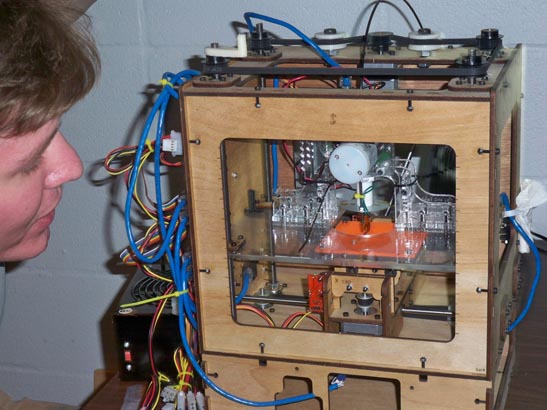
Im intrigued with the research at Solheim Additive Manufacturing Laboratory in the Mechanical Engineering Department on the University of Washington campus. If only I could create in the computer and then digitally print out my form in clay in my own studio, like they are doing at this lab. I think this would be a viable resource for me. I know that the open source “free” 3d printers like Rep Rap or maker bot have some attachments to digitally print in clay, and I’m waiting to see how these evolve.
I think another resources is materialize by .mGX for going directly to bronze, though very expensive. I have visions of using them on an intricate piece similar to Alfred Gilbert’s Virgin Mary or St. Michael. Pieces that would be a nightmare to recreate in a triditional bronze process but could easily be done with .MGX.
The very near future will drastically change the way I work. As many of the patents have ended on 3D printing, I believe you will begin to see a change in the cost factor and availability of home 3D printers. I still may be limited by the build size, unless, of course, I can figure out how to change a machine to accommodate my needs. I’m not sure I am that mechanically savvy.
As I write this, I find an aching. To go from screen to finished project without touching it leaves a hole inside of me. I am afraid I will not be able to “feel” the emotion of the piece unless I touch it. Oh, this is a strange thought.
Though looking at the quick sketches in my Mudbox video I can feel the emotion without touch. Will it feel the same digitally printed?
Remember, I am still a traditional artist. I get paid for a tangible piece of art. I need to get the sculptures out of the computer. I must base my choices on that final output.
This is an interview of 10 questions by Mathias Herbster of FH Vorarlberg University in Austria directed to Sculptor Bridgette Mongeon about the comparison of digital and traditional sculpture.
_____________________________________________________________________________

-Sculptor, Writer and Speaker
Bridgette Mongeon is a sculptor, writer, illustrator and educator as well as a public speaker.
Her blog can be found at https://creativesculpture.com.
She is also the owner and creator of the God’s Word Collectible Sculpture series
Follow the artists on twitter twitter.com/Sculptorwriter twitter.com/creategodsword
Facebook http://www.facebook.com/bridgette.mongeon
Listen to The Creative Christian Podcast or the Inspiration/Generation Podcast Click on Podcast Host Bios for a list of all podcasts.
Listen to the Art and Technology Podcast
What Makes Sculpting In Clay Appealing To You? An Austrian Student Interview Cont.
1. What makes sculpting in clay appealing to you?
I am a tactile person. I love the feel of clay in my hands, the softness of wet clay out of the bag allowing me to quickly rough in the general shape, the leather hard stage providing the perfect texture for carving in intricate details. The smell of earth, the sound of the water as it is sucked into dry clay in a cup— regenerating it into a malleable medium.
Working in this medium for over 25 years there is more. My brain has developed synapsis that are strictly 3 dimensional. I can quickly rough in a figure and gesture, bringing emotion to an object in clay, much faster than I can in a 2d sketch. In fact, I have noticed that my brain misfires, skips, or bluntly—farts when I am trying to bring thoughts from my brain into two dimensions, though I have continued to sketch my entire life, working in clay or a 3D form helps me to express that creativity quicker. My study of emotion in art, especially facial expression and psychology and science behind that, is exhibited in my sculptural forms and my creations of posthumous sculptures. I have trained myself in the precision of finding the emotion and transferring it to the clay. I’m not sure if this transpires in digital form. It probably does, and I do my best to explain it in my lectures, but it is a very abstruse, imperceptible process.
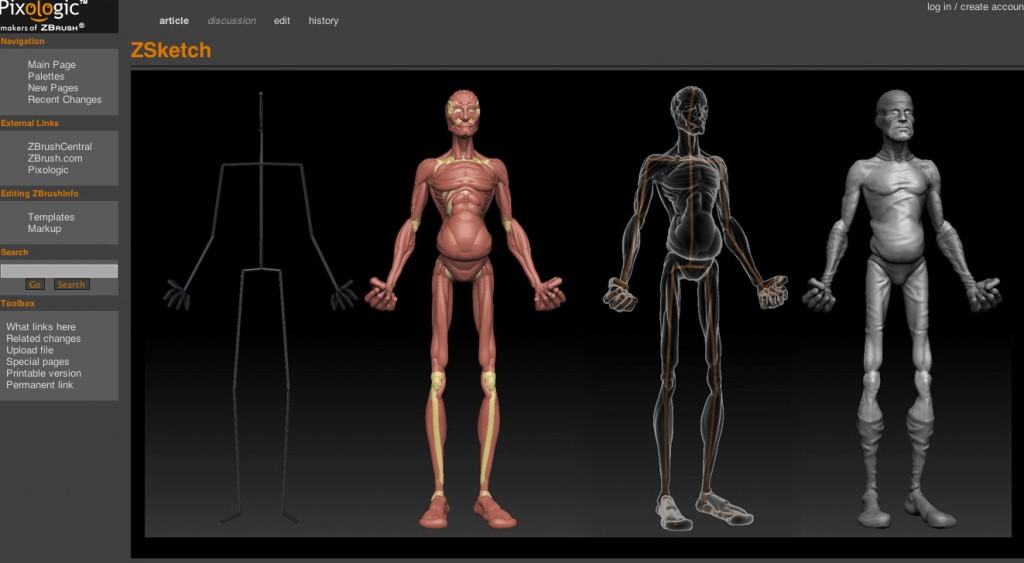
I must say that I do love the immediacy of the medium. I love being able to quickly squeeze and pinch or pull a shape out of a blob. This was probably my most frustrating aspect of digital sculpting, but is quickly changing. I hated having to be bound by the geometry under a piece, it still pisses me off from time to time. Zbrush’s zsketch is more in tuned to my traditional process though I am still butting up against geometry every now and then. I would say the same with being able to pose or move a piece. For me, doing this digitally (Zbrush, Mudbox) is time consuming and leaves me fumbling. I want to play with the form before finalizing it, and I do not feel as comfortable digitally with that as I would like. Some say the geometry is the armature. To me, that is a poor analogy, it is more like grit that is caught in my traditional clay and totally irritating me as I try to dance my hand over it.
This is an interview of 10 questions by Mathias Herbster of FH Vorarlberg University in Austria directed to Sculptor Bridgette Mongeon about the comparison of digital and traditional sculpture.
_____________________________________________________________________________

Sculptor, Writer and Speaker
Bridgette Mongeon is a sculptor, writer, illustrator and educator as well as a public speaker.
Her blog can be found at https://creativesculpture.com.
She is also the owner and creator of the God’s Word Collectible Sculpture series
Follow the artists on twitter twitter.com/Sculptorwriter twitter.com/creategodsword
Facebook http://www.facebook.com/bridgette.mongeon
Listen to The Creative Christian Podcast or the Inspiration/Generation Podcast Click on Podcast Host Bios for a list of all podcasts.
Listen to the Art and Technology Podcast







